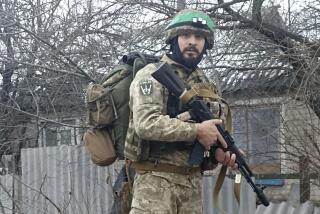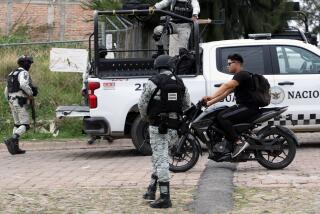Rebels’ Arsenal Fuels Urban War Fears
- Share via
WASHINGTON — Colombian guerrillas are using a new generation of complex explosives, including suspected poison gas on at least one occasion, to mount a more aggressive style of urban warfare that they hope will allow them to influence approaching elections, U.S. officials say.
With training from members of the Irish Republican Army, the rebels have learned to lob gas-filled mortar shells, the officials say. And the guerrillas reportedly have picked up techniques for sabotaging members of police and military bomb squads.
In the course of a 38-year war, the Colombian rebel groups have operated primarily in the countryside. But with outside help, the rebels have honed their arms expertise, and there is growing fear that they will use their new weapons to attack Colombian cities, U.S. officials say.
Such attacks would be designed “to show that [the rebels] are a much greater force than some people have thought,” said one U.S. defense official, who asked to remain unidentified. The rebels have been pressuring voters ahead of legislative elections to be held Sunday and a round of presidential elections scheduled for May 26.
Bush administration officials are now engaged in an internal debate about what more they should do to help the Colombian government in a war that involves two rebel groups, as well as several paramilitary organizations.
By law, the United States can provide military aid to Colombia to fight drug trafficking there. But some U.S. officials believe that aid should be sharply increased because of the terrorist threat the rebel groups pose to those in the region and to Americans. They point to the groups’ growing weapons savvy as one sign of the dangers they pose.
The know-how for building homemade mortars reached Colombia several years ago through a roundabout route that U.S. officials say illustrates how terrorist weapons technology flows around the world.
IRA members first learned to use the mortars in terrorist training camps in Libya more than a decade ago, officials say. They shared the technique with Basque separatists in Spain, who in turn passed it on to leftist rebels in El Salvador. Those rebels passed it to insurgents in Nicaragua and Panama, who in turn were the first to show it to Colombian rebels, officials say.
A key source of the weapons expertise has been the IRA, which is believed to have been training members of the Revolutionary Armed Forces of Colombia, the largest rebel group, since the mid-1990s.
The IRA members do not share a political ideology with the rebels, but they are drawn to Colombia as a way of making money and testing their weapons, U.S. officials say.
The Colombian rebels have used the expertise they gleaned from others to make rudimentary mortar shells consisting of modified cooking-gas canisters. A smaller canister, much like ones used on home barbecues, is filled with explosives and shrapnel and fired from a larger canister that functions like a mortar barrel.
The rebels have been using these weapons to bombard police and army buildings, though the canisters have often gone astray and struck homes, often with deadly results. The weapons are highly imprecise, but they can hurl canisters hundreds of yards.
U.S. officials believe that the rebels are now using poison gas in a more complex and deadly variant of the weapon. A gas such as chlorine can damage the lungs in a brief exposure; concentrated in a confined space, it can kill.
In September, rebels used a gas-filled canister in an attack on a police station in the southern town of San Adolfo, about 230 miles south of Bogota, Colombia’s capital. Four police officers were killed by the gas, which was released in a closed space. Officials have theorized that the substance was a poison gas or a tear gas made deadly by its concentration.
Col. Joaquin Correa, the local police commander, said in an interview Thursday that evidence from the attack has been sent to a private laboratory in the United States. “It could be months” before the lab results are known, he said.
U.S. officials say the rebels are also learning how to strike at authorities with booby-trapped explosives. Mortar canisters are being rigged with delayed fuses so that they can be lobbed into a building without exploding; when a bomb squad comes to deactivate them, the canisters go off, a defense official said.
And the rebels have learned how to detonate the canisters before they hit the ground, raining shrapnel or other material on their targets, officials say. The rebels have been known to use human feces in this way, creating a crude biological weapon that frightens the target and spreads infection, they say.
Other than these devices, the Colombian rebels’ weapons are primarily Soviet-era small arms purchased from Middle Eastern weapons merchants or left over from the Central American wars of the 1980s.
*
Times staff writer T. Christian Miller in Bogota contributed to this report.
More to Read
Sign up for Essential California
The most important California stories and recommendations in your inbox every morning.
You may occasionally receive promotional content from the Los Angeles Times.










